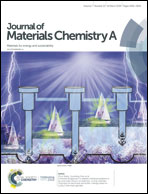Superior electrostrictive strain achieved under low electric fields in relaxor ferroelectric polymers†
Abstract
Ferroelectric polymers represented by poly(vinylidene fluoride-trifluoroethylene) show great potential for applications in actuators, sensors and artificial muscles. However, the excellent electrostrictive properties of ferroelectric polymers are achieved under high applied electric fields, which not only reduce their lifetime and reliability but also significantly limit their applications in wearable electronics and sensors. Here, we report a new class of relaxor ferroelectric polymers, which exhibits outstanding relaxor ferroelectric behavior including the highest dielectric constant of 75 among the known polymers, the maximum displacement of 12.3 μC cm−2, and a great dielectric strength of 400 MV m−1. Notably, the record electrostrictive strains in comparison to the state-of-the-art ferroelectric polymers have been achieved at both low applied electric fields, e.g. −2.5% at 50 MV m−1 and high electric fields, e.g. −13.4% at 275 MV m−1. The actuation of the relaxor polymer film can be driven even by using a household voltage of 220 V. In addition, the prepared polymer displays the highest elastic energy density and the best electromechanical conversion efficiency when compared to the current ferroelectric polymers.



 Please wait while we load your content...
Please wait while we load your content...